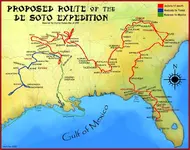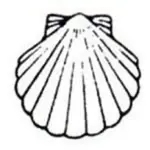- #161
Thread Owner
Well, I escaped from the hospital this morning. Thank you for the prayers and good wishes, they are very much appreciated. Thanks ProspectorMikel for letting the folks know I hadn't forgotten them.
Enough about mining to get myself in trouble maybe...
The "patio process" , using mercury began around 1554.
Prior , smelting was done heating ore to extract silver.High grade ore was the desired deal. And less high grade was still being mined then.
The lower grade ores remaining meant less efficient extraction. Plus "The New Laws Of The Indies" took native American Indians off the table as semi slave laborers...
Silver production was not doing good.
The patio process got it going again.
That does not end previous methods. Does not ensure previous methods continued , but smelters were the end of the trail for ore regardless of its form prior.
Most ore was likely taken to a smelter pre patio process. Find a furnace/smelter in the bush and bars could have resulted. At risk of being caught though ,and dependent on fuel and labor , food for that labor ,ect...
Lots of reading here...
DigiTool Stream Gateway Error
There is a chapter in my book, about silver “dirty “bars.
About twenty miles south of my house, there was a pack train that was attacked in a creek crossing and a few mules were lost and silver lost.
Later on, down stream a few miles, a farmer was plowing a plot close to the creek. He hit several of these metallic bars and threw them into a pile.
Here is the link to this story...
This farmer was the father of a lady that my first partner knew when she was an elderly lady, and my partner was a young man.
He told me this story, that she had told him.
She had watched her father throwing the chunks of unknown material, and kicking the ground in frustration.
Here parents talked about it while eating supper, but she didn’t understand what it was about.
The next day a neighbor stopped by, on his way to town to see if they needed anything.
The man and her father talked then they went down to the creek and looked at the pile. They came up and took his wagon to the creek and loaded it up and they all went to town.
What she remembered most clearly was that she and the rest of the family got new shoes and brand new, Sunday clothes and Mom got a new cook stove.
My partner, Jim explained that the creek was in narrow banks where the old story about the silver was lost and that the farm was in the first open area for the water to loose speed and allow heavy objects to fall out of the flow during heavy flooding. So the bars were never going to be moved again by water.
The bars were not what we generally think of when we hear, silver bars.
They were made from low quality ore and poured into trenches carved into the ground, and when cooled they were pulled out and more were poured.
They were then shipped via pack mule , to another location to be purified and marked etc...
?? Were all of the parts of the story true and correct, that Jim told me
I have never had a reason to doubt him, and I have been his friend for most of my life.
I believe that your earlier posts seem to follow the same process and patterns.
#/;0{>~
They were headed south.
But where did they originate?
There is silver in Madison County according to court records of the trial of two counterfeiters that were caught because the coins that they were making were of better silver than the silver coins from the mints.
The records stated that they both said that the mine was was within a half day walk from the court house.
Nobody ever got them to give the location, and they didn’t come back to Madison County when they got out of prison.
“Good speed report for Madison County Arkansas “
#/;0{>~
Great story, dog, I think you've posted it before re origins of the Winnebagos being in the Southwest.
OK, the packtrain load was called "whitestone". This changes things a bit. As releventchair states in Post #142, silver was generally extracted from silver-bearing ore using the patio process, which required crushing the rock then spreading the fines in a big shallow rock basin mixed with water, mercury and salt to reduce the mess to more concentrated silver slimes. It took quite a while because the stew had to be stirred and mixed numerous times. Recovery percentage was fair to middling. Then the stuff was smelted. It was tedious. That's why I speculated that Spanish prospectors so far away from Mexico were much more likely to be seeking gold. It was easier and promised a better payoff if they were successful.
However, these miners in the story may well have found a deposit of native silver in their travels. From the historical account, it seems quite likely the miners were ambushed somewhere in southern CO, where native silver (pure metal) has a significant history all over the mining districts there. As you can see by the photo (from Creede CO), the stuff could well be called whitestone in its original form. If this was the case (speculation), the miners would not have needed to treat or smelt their find, since it was already pure out of the ground. Just pack up their lucky find and go home. As far as your cache is concerned, wherever the Winnebagos dumped it "in the woods", the stuff soon became tarnished black, wherever it was dumped.
View attachment 1675388
mdog,
Following old trails I read about or see on old maps has been one of my life's joys, also. Lumholtz's "Unknown Mexico" was my inspiration and guide to explore from Basasciache, Chihuahua to La Bufa, in the Barranca del Cobre, exiting the Barranca at San Rafael.
I once followed a road shown on a 1765 map that went through country that presently has no road. It was a 40mile walk. All I had was a hat and a pocket knife, but I found a spring or a tank every hour or so and some beautiful rockwork along steep, wall clinging inclines.
Keep on truckin! You never know what's around the next corner.
WH
Thanks Mikel. How can you tell that they were moving south.
You might be able to get some idea, about where they came from, by going to your county engineer and asking him for the original county survey notes. Sdcfia posted a link, in another thread that was really nice, but it didn't cover the whole United States.
https://glorecords.blm.gov/search/default.aspx
I used it to find the Indian and trading trails in my county. If you know the approximate location of where the silver bars were found, you might find a description of a trail in the survey notes.
Thanks Sdc. Would the prospector have found silver that pure as an outcropping? And if so, would the silver that was exposed to the air be black? If it turns black, when exposed to air, would the fraud be exposed if the ore was used to salt a claim?
Thanks Mikel. How can you tell that they were moving south.
You might be able to get some idea, about where they came from, by going to your county engineer and asking him for the original county survey notes. Sdcfia posted a link, in another thread that was really nice, but it didn't cover the whole United States.
https://glorecords.blm.gov/search/default.aspx
I used it to find the Indian and trading trails in my county. If you know the approximate location of where the silver bars were found, you might find a description of a trail in the survey notes.
View attachment 1676314I spent some time looking at these and I think the best clue, for solving the mystery, is that petroglyph of the capital M and the eye right below it that Sdcfia posted on post #55.


My late partner Jim said that there was a king’s smelter on the Arkansas River.
They would have the clean up pure ingots ( the mine boss’s share)
If they had been coming from the south.
The knowledge that there is a record that states the counterfeiters said that there was enough silver in their mine to pave every road in the county !
The name of the area where they were making the coins is in the court documents; However, I stumbled into an old map that showed another place by the same name, that is much closer to me and Weekender’s site.
And that all may be enough to make us go back and look a bit more closely.
#/;0{>~
That reference to the King's smelter on the Arkansas River sounds interesting. Do you know much about that?
I don't blame you for checking out your site. That's a lot of silver.
View attachment 1676633Here is some more info on it i will respond shortly on this.
MDOG, first of all welcome back!
And secondly, the story was Jim ‘s but I believe that it was true. He may have told me a few stories, two or three times, but they were the same each time. And up until the last six months of his life the only thing that would catch him off about was an occasional name. I was taking notes so that I could remember them, and I have those notes put up in a safe place, that I am sure I will find... someday.
When Orangeman and I have compared notes and photos of very similar markers that we have in common, we started looking for a common person or team.
De Soto was the first name that we found, but there were way too many different versions from his journal and his officers and soldiers, and even too many interpretations of the records to lock him in as the source to lock him in.
But we do know that he did manage to use and cross the Arkansas River in 1540 or 1541, just before his death in1541 at the mixing of the waters of the Arkansas River and the Mighty Mississippi River during a spring thawed following a record snowfall melt that widened the Mississippi so far that they thought it was the Gulf
(Of Mexico).
His most likely route was between our site and Orangeman’s! A seventy mile strip, as the crow flies.
So even if we failed to lock him at both places, the logistics would support that there was some common ground somewhere around the Arkansas River. The possibility still seem to point to that area.
There are two accounts for the counterfeiters. One was in the good speed report, and a later report of the same men, and a report that the Sheriff and a few others took photos of the silver coins , in peach baskets only a few inches deep, but with several layers of baskets stacked two and three layers deep on an old flat bed truck that stagers my imagination.
The name and proximity to the King mine of the place with the matching name, simply ties the knot a bit tighter.
Just building blocks of a half baked theory, yearning to be proven.
More to come...
#/;0{>~



View attachment 1676768
He was right at a gold producing region when he passed through northwest Georgia and northeast Alabama. Mikel, did any accounts of the expedition mention anything about finding gold? You would also think that he would be marking his trail, in some way.
